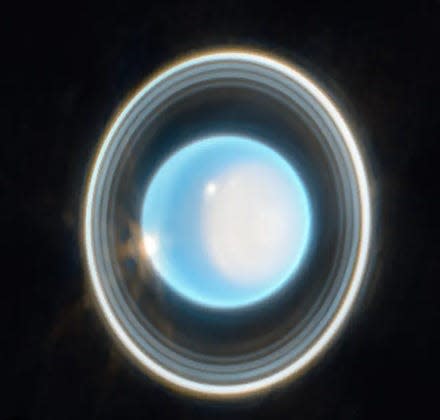The upcoming mission to Uranus
This article was partially contributed to by ChatGPT generated content.
The exploration of Uranus has long been a tantalizing prospect for astronomers. Situated in the distant reaches of the Solar System, 20 times farther from the Sun than we are, Uranus remains shrouded in mystery. The seventh planet in our celestial lineup, Uranus stands apart as the first not to be recognized before the invention of the telescope. Uranus is actually visible in the night sky with the naked eye as a very dim star, and centuries of stargazers mistook it as such before William Herschel, using the most advanced telescopes of his era, identified it as a planet in 1781. For millennia, astronomers only knew planets until Saturn. The discovery of Uranus, the first planet unknown to the ancients, is a watershed moment in the history of astronomy.
One of the most peculiar attributes of Uranus is that it spins on its side, a characteristic not shared by any other known planet. We have seasons on Earth because our planet spins with a moderate angle: in June the northern hemisphere gets more direct sunlight than the southern hemisphere, the situation reversing six months later, in December. Uranus is so tilted that when it’s summer in their northern hemisphere, Uranus north pole points directly at the Sun, and the entire southern hemisphere is engulfed in darkness. Uranus’ orbit around the Sun takes 84 years, so each hemisphere experiences 42 years of light, followed by 42 of night. Did a collision happen to tilt Uranus into this strange configuration? Did other planets experience similar collisions? We don’t know.
Despite its intrigue, Uranus has been visited by a spacecraft only once. The Voyager 2, launched in 1977, on its grand tour of the outer realms of the Solar System, paid Uranus a historic visit on January 24, 1986. All our knowledge of Uranus comes from telescope observations, and this one-time fly-by.
Planets can be categorized into four distinct types. First, there are the “terrestrial”, or “rocky” planets—Mercury, Venus, Earth, the Moon, and Mars—made most of iron and rock. Then come the gas giants—Jupiter and Saturn—dominated by colossal atmospheres of hydrogen and helium. We have also the ice dwarf worlds, exemplified by Pluto and most of the moons accompanying the giant planets. These worlds tend to be the size of the Moon and smaller, and composed mostly of water ice. Finally, there are Uranus and its twin sibling, Neptune, similar in mass and size. These planets are composed, according to our best knowledge, of mostly water ice, like Pluto. However, they are each 15 times more massive than the Earth, and all we see of them from the outside are their clouds, like the gas giants. These characteristics warrant them the nickname “ice giants”. Uranus and Neptune serve as prototype of an entire category of planets. Since 1995, astronomers have found over 5,000 extrasolar planets, planets orbiting other stars than the Sun. Many of these have about the same mass and radius as the ice giants, so it is reasonable to assume they are similar to Uranus and Neptune. A more in-depth knowledge of the planets in our backyard will better inform our understanding of these distant worlds around other stars.

Yet, despite the remarkable strides made in space exploration, the ice giants remain among the least explored planets in the Solar System. The Galileo and Cassini missions surveyed Jupiter and Saturn. Uranus and Neptune, being much further out (twice and three times the distance of Saturn), are a more difficult target. A number of missions to Uranus have been proposed, but none has been approved.
This decade may see a change in it, as the Uranus Orbiter and Probe was selected as highest priority mission for this decade by the community of planetary scientists that advises NASA. A launch would happen in the late 2020s or early 2030s, with the spacecraft reaching Uranus in the mid-2040s.
In embarking on a mission to Uranus, we’re bound to reshape our understanding of not only this distant ice giant but also the broader class of exoplanets it represents. In doing so, we open a new chapter in the grand narrative of human exploration, pushing the boundaries of our knowledge and expanding our horizons to distant realms.
Wladimir Lyra is an associate professor of astronomy at New Mexico State University. He can be reached at @LyraKstellation (twitter) or wlyra@nmsu.edu (email).
This article originally appeared on Las Cruces Sun-News: The upcoming mission to Uranus
